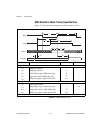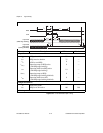
Chapter 5 Signal Timing
DIO 6533 User Manual 5-14 © National Instruments Corporation
Leading-Edge Mode
In leading-edge mode, the 6533 device and the peripheral device send
each other pulses on the ACK and REQ lines. The leading edge of the
ACK or REQ pulse indicates that the 6533 device or peripheral device
is ready for a transfer.
Input
In input mode, the 6533 device sends an ACK pulse when ready to
receive data. The ACK pulse width is fixed, assuming the peripheral
device has deasserted the REQ signal. Otherwise, the ACK signal
remains asserted until the REQ signal deasserts. After receiving at least
the leading edge of the ACK pulse, the peripheral device can strobe data
into the 6533 device by asserting the REQ signal. The 6533 device
sends another ACK pulse when ready for another input.
To slow down the handshake, you can specify a data-settling delay to
occur before the ACK signal.
Output
In output mode, the 6533 device sends an ACK pulse after driving
output data to indicate new, valid output data. The ACK pulse width is
fixed, assuming the peripheral device has deasserted the REQ signal.
Otherwise, the ACK signal remains until the peripheral device deasserts
the REQ signal. The peripheral device can latch the data on the falling
or rising edge of the ACK signal, or at any time before returning a REQ
pulse. The peripheral device must respond with an active-going REQ
signal edge to deassert the ACK signal and request additional data.
To slow down the handshake, you can specify a data-settling delay to
occur before the ACK signal. This delay increases the setup time from
valid output data to the ACK signal.


















